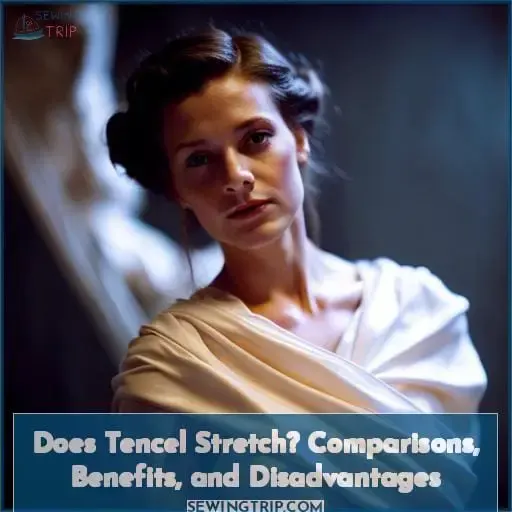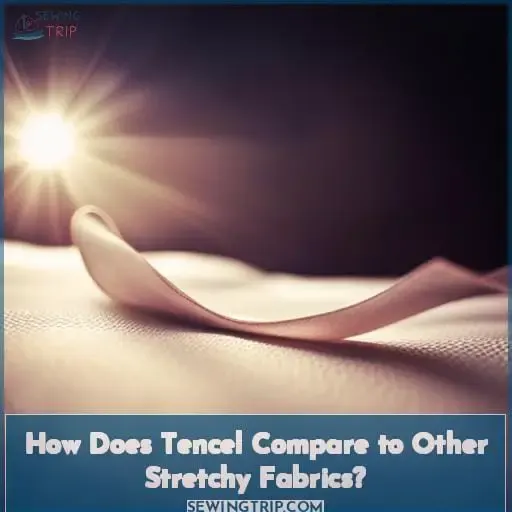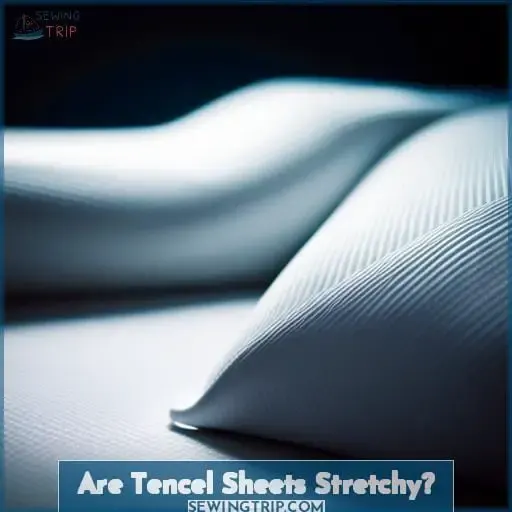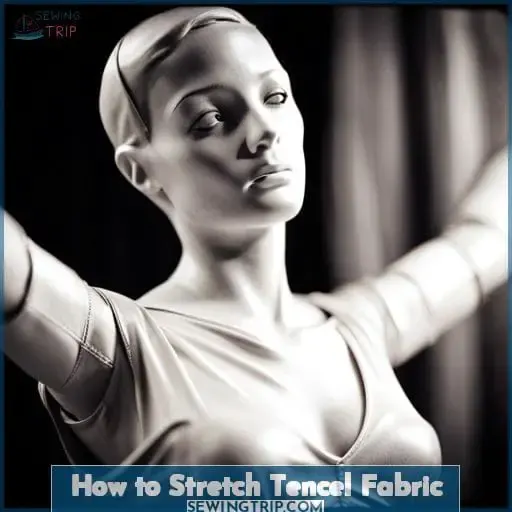This site is supported by our readers. We may earn a commission, at no cost to you, if you purchase through links.
 Curious about whether tencel stretches? You’re not alone. Tencel is a revolutionary fabric that has taken over from cotton as the best fabric for jeans, so it’s only natural to want to know if its properties extend beyond comfort and smoothness.
Curious about whether tencel stretches? You’re not alone. Tencel is a revolutionary fabric that has taken over from cotton as the best fabric for jeans, so it’s only natural to want to know if its properties extend beyond comfort and smoothness.
Let’s explore how Tencel compares with other stretchy fabrics, what it looks like in jeans and sheets and discuss the benefits of this amazing material as well as any potential drawbacks.
So let’s dive right in; does tencel stretch? Yes! While its official website doesn’t mention anything about stretching, one denim expert confirms that when blended into denim along with cotton fibers, Lyocell creates an incredibly soft pair of pants with remarkable stretching capabilities.
Table Of Contents
Key Takeaways
- Tencel has minimal stretch, stretching approximately 5% in all directions.
- Tencel can be reshaped by wetting it and gently pulling.
- Known for its smooth feel, antibacterial properties, and breathability, Tencel is a fabric that requires blending with other fibers to add stretch.
How Does Tencel Compare to Other Stretchy Fabrics?
When compared to other common fabrics, pure Tencel lyocell has only a minimal amount of stretch. Its approximately 5% stretch in all directions offers some give, but much less than super-stretchy elastane, which can stretch up to 600%, while cotton, linen, and polyester have even less give than Tencel.
Comparison With Cotton
You’ll find Tencel has minimal stretch compared to your favorite cotton jeans that ease up over time.
- Cotton provides more give than Tencel over time.
- Tencel jeans retain their shape; cotton softens with wear.
- Cotton sheets stretch and pucker; Tencel resists wrinkling.
- Blending Tencel with elastane boosts stretch for activewear.
Comparison With Elastane
You feel elastane’s significant stretch when wearing spandex activewear, whereas tencel’s minimal stretch maintains the shape of jeans. Blending elastane and tencel balances stretch with structure for fitted yet mobile garments.
Elastane provides up to 600% stretch, outperforming tencel’s approximately 5% stretch. However, pure tencel retains its original shape after gentle stretching. Garment designers blend tencel with spandex for versatile, comfortable stretch in activewear and shapewear.
Comparison With Linen
When tugging linen, expect it to resist stretching and potentially tear. Unlike Tencel’s slight give, linen has no inherent elasticity. Pulling linen risks damaging the fabric’s structure. While Tencel incorporates some stretch, pure linen lacks any elasticity.
- Tencel has slight stretch.
- Linen has no stretch.
- Tencel stretches more when wet.
- Linen stays rigid when wet.
- Linen risks tearing if stretched.
Comparison With Polyester
Unlike polyester’s minimal stretch, Tencel boasts slight elasticity for a touch more comfort. You’ll appreciate Tencel’s affinity for moisture and body heat because polyester tends to get clammy. Blending the two yields a fabric with Tencel’s strength when wet and polyester’s wrinkle resistance.
Tencel alone gently stretches and recovers its shape, remaining smooth against the skin.
Is Tencel Stretchy in Jeans?
Since pure tencel has minimal stretch, designers often blend it with elastane to boost the flexibility of tencel jeans.
- Tencel’s smooth, soft feel makes it ideal for comfortable jeans when blended with around 3-5% elastane for stretch and recovery.
- The elastane content gives tencel denim the stretch and flexibility needed for active wear while tencel provides strength, durability and comfort.
- Tencel blended with elastane results in jeans that hold their shape well throughout the day without sagging or losing their fit.
Despite having only about 5% natural stretch, tencel takes on a measure of flexibility when combined with the highly elastic elastane fiber. This blend is key for creating soft, durable denim that moves with you while maintaining its flattering silhouette wash after wash.
The stretch resistance of tencel works in harmony with elastane to create jeans that keep their shape without restricting motion.
Are Tencel Sheets Stretchy?
You might wake up sore if 100% Tencel bedsheets don’t give while you toss and turn. Unlike spandex or elastane, which boast incredible stretch, Tencel offers minimal give. Its wood pulp origin provides breathability and softness but not much elasticity.
Still, blending Tencel with fibers like spandex or microfiber lends stretch for sheets that contour to your shape. Proper care preserves the longevity of Tencel bedding. While pure Tencel withstands wrinkles, retaining its supple drape and silkiness, high heat damages its sustainability.
Follow gentler wash cycles and air dry Tencel sheets to retain their signature smoothness. For bedding that cradles without restricting, a touch of spandex balances Tencel’s natural comfort with the stretch needed for a restful night’s sleep.
Does Tencel Stretch as You Wear It?
Tencel will mold to your shape over time. Although 100% Tencel has minimal stretch, it will adapt to your contours as you wear and wash it.
This happens through:
- Body heat
- Movement
- Washing
- Time
Over months of wear, Tencel garments and bedding take on the shape of your body. The fibers loosen and yield more easily to accommodate your shape. This molding effect enhances comfort, especially for sensitive skin. While Tencel itself doesn’t stretch much, blending it with elastane or spandex boosts the stretchability.
On its own, Tencel’s breathability and supple hand make it feel surprisingly stretchy.
So give your Tencel items a chance to conform to your body. With patience, they’ll become custom-fit just for you.
How to Stretch Tencel Fabric
- Wet the garment in lukewarm water and gently massage to fully saturate. Avoid hot water, which can damage fibers.
- Identify areas needing stretch. Sleeves, waistbands and hems are common.
- Gently pull and elongate the fabric in the direction of stretch. Apply even tension.
- Reshape on a flat surface or drying rack, smoothing and pinning to hold the new shape.
With care, Tencel can be refreshed and carefully coaxed into a better fit. By rewetting and gently elongating the fabric, you can ease areas that have become too snug and restore the garment’s original drape and flow.
Tencel will retain its new dimensions after air drying. Handle with care and patience.
What Are the Benefits and Advantages of Tencel Fabric?
When choosing fabrics for clothing and home textiles, look for Tencel lyocell. Tencel’s smooth feel against skin, antibacterial properties, and breathability make it one of the most comfortable manmade fibers available.
Comfort and Smooth Feel
The soft Tencel glides across your skin, leaving you amazed by its smooth, silky feel. The lightweight, breathable fabric provides unparalleled comfort with its antibacterial properties that are perfect for sensitive skin.
Tencel is ideal for clothing, bedding, and anything needing a luxuriously soft touch.
Antibacterial Properties
You’d love how the antibacterial properties of Tencel keep your skin healthy and fresh when wearing it. The eco-friendly fabric wicks moisture and resists bacteria, controlling odors even in hot weather.
Its soft and breathable feel alongside antibacterial benefits make it ideal for clothing and bedding to nurture your skin. Tencel’s moisture control and antibacterial properties explain its popularity in fashion and home goods.
The breathable, antibacterial fabric keeps skin fresh by resisting bacteria growth. With moisture-wicking abilities, Tencel controls odors in hot weather. The soft, breathable feel makes Tencel well-suited for clothing and bedding.
Tencel’s moisture control and antibacterial traits have led to its prevalence in fashion and household items.
Temperature Regulation
You can stay cool and comfortable with Tencel sheets, like the eucalyptus Tencel queen sheet set that wicks moisture and regulates temperature for a cooling night’s sleep.
- Breathable and moisture-wicking,
- Temperature regulating,
- Antibacterial and odor resistant,
Tencel’s advanced fiber properties allow it to excel at moisture and heat management, keeping you drier and more comfortable than traditional sheets.
What Are the Disadvantages of Tencel Fabric?
Though praised for its sustainability, Tencel may disappoint those seeking significant stretch. The inherently stiff fiber offers minimal stretch and recovery compared to elastane or spandex blends. Without sizing treatments, Tencel fabric and clothing can shrink considerably. To unlock Tencel’s versatility and enable stretch, textile manufacturers must blend it with other fibers – a challenging process.
Yet synthetic blends compromise Tencel’s biodegradability. For the environmentally conscious, its production requires intensive chemical use. While admired for its breathability and moisture control, Tencel needs gentler laundering than robust synthetics like polyester.
Ultimately, Tencel works best in garments prioritizing comfort and fit over mobility. With reasonable care and realistic expectations, its natural softness and temperature regulation still delight.
Here is a 3 column and 5 row table comparing the stretch properties of Tencel to other common fabrics:
| Fabric | Stretch Amount | Stretch Recovery |
|---|---|---|
| Tencel | Minimal, 5% | Good |
| Elastane | Very high, up to 600% | Excellent |
| Cotton | Slight with wear | Fair |
| Polyester | Minimal | Good |
| Linen | None | Poor |
Conclusion
Tencel fabric makes an excellent choice for comfortable and stylish clothing and home decor. It boasts antibacterial properties, temperature regulation, and a smooth feel, so it’s no wonder it’s growing in popularity among fashionistas and homemakers.
Its limited stretch can benefit those looking for a more structured look but also disadvantage those wanting more elasticity. With proper care and knowledge, Tencel fabric can successfully stretch to fit the desired purpose.
If you’re looking for a lightweight, breathable, durable fabric, look no further than Tencel.













